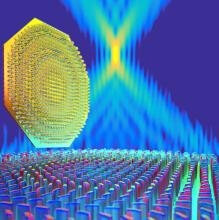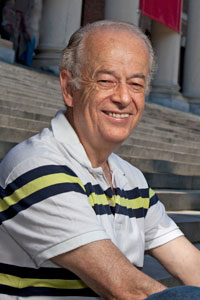News
This ultra-thin planar lens developed at SEAS was named a runner-up for Science's Breakthrough of the Year 2016. (Image courtesy of Peter Allen/Harvard John A. Paulson School of Engineering and Applied Science)
Research done at the Harvard John A. Paulson School of Engineering and Applied Sciences (SEAS) was listed among the breakthroughs of the 2016 by the journals Nature and Science.
A flat metalens, developed in the lab of Federico Capasso, the Robert L. Wallace Professor of Applied Physics and Vinton Hayes Senior Research Fellow in Electrical Engineering, was named a runner-up for Science's Breakthrough of the Year 2016. The lens is the first flat lens that can focus visible light with high efficiency and without distortions.
“These lenses can be designed with enormous flexibility and tailored for a wide range of applications,” said lead author Mohammadreza Khorasaninejad. “The metalens, thinner than a sheet of paper, can resolve nanoscale features separated by distances smaller than the wavelength of light.”
The research could have applications in the fields of camera modules for cell phones and laptops, wearable optics for virtual reality and augmented reality, flexible contact lenses or telescopes in space.
“Industrial interest in our work has been very large, from lens makers to cell phone companies. We are exploring commercialization of this technology, which is compatible with integrated circuit mass production,” said Capasso.
The research was coauthored by Wei Ting Chen, Rob Devlin, Jaewon Oh and Alexander Zhu and supported in part by a MURI grant from the Air Force Office of Scientific Research, Draper Laboratory and Thorlabs Inc.
Read more about the research here.
The octobot, developed by Robert Wood, the Charles River Professor of Engineering and Applied Sciences and Jennifer Lewis, Hansjorg Wyss Professor of Biologically Inspired Engineering, was listed among Nature’s editor's choices for 2016. Wood and Lewis are also core faculty members of the Wyss Institute for Biologically Inspired Engineering.
The octobot is the first entirely soft, autonomous robot. Inspired by the fluid motions of an octopus, this small, 3D-printed robot could pave the way for a new generation of completely soft, autonomous machines.
“One long-standing vision for the field of soft robotics has been to create robots that are entirely soft, but the struggle has always been in replacing rigid components like batteries and electronic controls with analogous soft systems and then putting it all together,” said Wood. “This research demonstrates that we can easily manufacture the key components of a simple, entirely soft robot, which lays the foundation for more complex designs.”
The paper was co-authored by Ryan Truby, Michael Wehner, George Whitesides, the Woodford L. and Ann A. Flowers University Professor, Ryan Truby, Daniel Fitzgerald and Bobak Mosadegh, of Cornell University.
The research was supported by the National Science Foundation through the Materials Research Science and Engineering Center at Harvard and by the Wyss Institute.
Read more about the research here.
Cutting-edge science delivered direct to your inbox.
Join the Harvard SEAS mailing list.
Scientist Profiles
Robert J. Wood
Harry Lewis and Marlyn McGrath Professor of Engineering and Applied Sciences
Federico Capasso
Robert L. Wallace Professor of Applied Physics and Vinton Hayes Senior Research Fellow in Electrical Engineering
Press Contact
Leah Burrows | 617-496-1351 | lburrows@seas.harvard.edu


